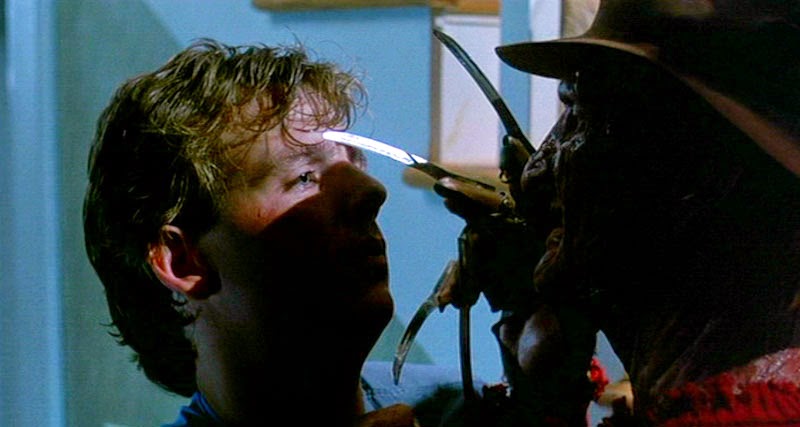A Nightmare on Elm Street 2: Freddy's Revenge (1985)
A Nightmare on Elm Street 2: Freddy’s Revenge (1985)
Directed by Jack Sholder;
Starring Mark Patton, Robert Englund, Helen Langenkamp
Rating: 3/5
It’s been a few years since
Freddy Krueger first returned from the dead and began killing teenagers in their
dreams. Then he was defeated by Nancy Thompson, who pulled him into the waking
world for a final showdown. Now he’s back for some… revenge?
Bizarrely, even though
Freddy’s motivation from the get-go has been revenge and all the other films in
the series are specifically about Freddy’s
Revenge, this is the only one that isn’t. Freddy usually targets the Elm
Street children, the surviving children of the parents who first killed him,
but here he pick on the new family has moved into Nancy’s old house.
Still, this is a very minor
gripe, as this is the first sequel and the series could have gone in any direction
at this point. What the film makers decided to do with this one ended up being
unique, and has a lot more going for it than your average slasher sequel.
Freddy’s plan this time is to
inhabit the body of his primary victim, Jesse Walsh (Mark Patton) whose family
has moved into the house. In his first face-to-face encounter with Jesse,
Freddys says ‘I’ve got the brains, and you’ve got the body.’ Cue some classic
Freddy body horror as he rips apart his skull to expose his brain.
This means that Freddy spends
more time breaking into the real world to kill people in the flesh than he does
setting up the elaborate and ironic dream sequences that would come to define
the rest of the series. He slowly takes over Jesse’s body to achieve this,
creating a more potent and personal journey than characters in other Nightmare films experience. This film is
about Jesse’s dilemma, and his feelings of confusion and isolation.
Specifically, this is that
Freddy’s manipulation of his body represents a latent homosexuality, which
Jesse is confused and terrified by, and as a result resists. He exhibits
self-hatred, and is continually torn between whether his actions are the result
of an uncontrollable possession, or something else inside himself.
Certainly the openly gay actor
Mark Patton and screenwriter David Chaskin have acknowledged these themes.
Director Jack Sholder was apparently naïve to this, and unwittingly accentuated
the subtext when surrendering to the movie’s naturally camp aesthetic.
There are many scenes in the
film which suggest this, most significantly the death of Jesse’s gym coach, who
he runs into in a leather bar. The coach comes across as very predatory,
forcing Jesse back to school to run laps. Jesse/Freddy’s response to this is to
strip ad whip the coach in the showers, before killing him with Freddy’s glove.
Not only is the main character
in the film a male, but the only characters who die in this film are male. This
is a significant reversal of the established slasher formula. The only major
female character in the film is Jesse’s girlfriend Lisa. They never consummate
their relationship the way they might in a bawdier slasher movie, although it
is their love for each other which eventually defeats Freddy.
Another recurring motif is of
heat, which could tie into the film’s other theme to represent an increasing
heat of sexuality. During some of the film’s few dream sequences, Jesse
experiences intense heat as objects in his room, such as vinyl records and
candles, melt around him. The film is bookended by dreams where Freddy appears
as a bus driver and drives Jesse’s school bus through the desert and into what
looks like hell.
In the real world, the house’s
thermostat is broken, and the toaster bursts into flames. Finally, in a
hilarious and surprising real world event, the family’s lovebirds become crazed
and cause chaos in the living room before exploding in a ball of flame.
A highlight of the Nightmare on Elm Street series is its
role as an ‘80s time capsule, more so than other slasher franchises, and this
instalment is no exception. Notable moments include Jesse’s room-cleaning
montage wearing ridiculous sunglasses, and the pool party scene, in which
Freddy appears to wreak havoc and terrorise the partygoers en masse. I also
love Jesse’s car, ‘The Dinosaur,’ a beaten-up convertible that he has to
hotwire every time he wants to start it.
In conclusion, there is
something very complex running through this film. The fact that such feelings
manifest themselves as Freddy and are ultimately destroyed could be seen to undermine
this film’s exploration of sexuality by suggesting it is something that is destructive
and must be defeated. It could be that Freddy represents not overt
homosexuality, but a general teenage confusion surrounding sexuality. Defeating
Freddy therefore means Jesse has reconciled his confusion and acknowledged his
feelings for Lisa.



Comments
Post a Comment